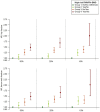Femoral neck width genetic risk score is a novel independent risk factor for hip fractures
- PMID: 38477772
- PMCID: PMC11240160
- DOI: 10.1093/jbmr/zjae002
Femoral neck width genetic risk score is a novel independent risk factor for hip fractures
Abstract
Femoral neck width (FNW) derived from DXA scans may provide a useful adjunct to hip fracture prediction. Therefore, we investigated whether FNW is related to hip fracture risk independently of femoral neck bone mineral density (FN-BMD), using a genetic approach. FNW was derived from points automatically placed on the proximal femur using hip DXA scans from 38 150 individuals (mean age 63.8 yr, 48.0% males) in UK Biobank (UKB). Genome-wide association study (GWAS) identified 71 independent genome-wide significant FNW SNPs, comprising genes involved in cartilage differentiation, hedgehog, skeletal development, in contrast to SNPs identified by FN-BMD GWAS which primarily comprised runx1/Wnt signaling genes (MAGMA gene set analyses). FNW and FN-BMD SNPs were used to generate genetic instruments for multivariable Mendelian randomization. Greater genetically determined FNW increased risk of all hip fractures (odds ratio [OR] 1.53; 95% CI, 1.29-1.82 per SD increase) and femoral neck fractures (OR 1.58;1.30-1.92), but not trochanteric or forearm fractures. In contrast, greater genetically determined FN-BMD decreased fracture risk at all 4 sites. FNW and FN-BMD SNPs were also used to generate genetic risk scores (GRSs), which were examined in relation to incident hip fracture in UKB (excluding the FNW GWAS population; n = 338 742, 3222 cases) using a Cox proportional hazards model. FNW GRS was associated with increased risk of all incident hip fractures (HR 1.08;1.05-1.12) and femoral neck fractures (hazard ratio [HR] 1.10;1.06-1.15), but not trochanteric fractures, whereas FN-BMD GRS was associated with reduced risk of all hip fracture types. We conclude that the underlying biology regulating FNW and FN-BMD differs, and that DXA-derived FNW is causally related to hip fractures independently of FN-BMD, adding information beyond FN-BMD for hip fracture prediction. Hence, FNW derived from DXA analyses or a FNW GRS may contribute clinically useful information beyond FN-BMD for hip fracture prediction.
Keywords: BMD; DXA; genome-wide association study (GWAS); hip geometry.
Plain language summary
Femoral neck width (FNW) derived from DXA scans may provide useful information about hip fracture prediction, over and above that provided by BMD measurements. Therefore, we investigated whether FNW is related to hip fracture risk independently of BMD, using a genetic approach. FNW was derived from points automatically placed on the hip in DXA scans obtained from 38 150 individuals (mean age 63.8 yr, 48.0% males) in UK Biobank. Seventy-one distinct genetic factors were found to be associated with FNW. Individuals who were predicted by their genes to have greater FNW had a higher risk of hip but not forearm fractures. In contrast, those with greater genetically determined BMD of the femoral neck had a lower risk of both hip and forearm fractures. We conclude that the underlying biology regulating FNW and BMD of the femoral neck differs, and that FNW derived from DXA analyses may contribute clinically useful information beyond BMD for hip fracture prediction.
© The Author(s) 2024. Published by Oxford University Press on behalf of the American Society for Bone and Mineral Research.
Conflict of interest statement
None declared.
Figures



Similar articles
-
Effects of femoral neck width and hip axis length on incident hip fracture risk: a registry-based cohort study.J Bone Miner Res. 2025 Mar 15;40(3):332-338. doi: 10.1093/jbmr/zjaf019. J Bone Miner Res. 2025. PMID: 39869781 Free PMC article.
-
Fracture Risk Indices From DXA-Based Finite Element Analysis Predict Incident Fractures Independently From FRAX: The Manitoba BMD Registry.J Clin Densitom. 2019 Jul-Sep;22(3):338-345. doi: 10.1016/j.jocd.2019.02.001. Epub 2019 Feb 8. J Clin Densitom. 2019. PMID: 30852033
-
Association of incident hip fracture with the estimated femoral strength by finite element analysis of DXA scans in the Osteoporotic Fractures in Men (MrOS) study.Osteoporos Int. 2018 Mar;29(3):643-651. doi: 10.1007/s00198-017-4319-2. Epub 2017 Nov 22. Osteoporos Int. 2018. PMID: 29167969 Free PMC article.
-
Prediction of incident hip fracture with the estimated femoral strength by finite element analysis of DXA Scans in the study of osteoporotic fractures.J Bone Miner Res. 2014 Dec;29(12):2594-600. doi: 10.1002/jbmr.2291. J Bone Miner Res. 2014. PMID: 24898426 Free PMC article. Clinical Trial.
-
Use of DXA-based finite element analysis of the proximal femur in a longitudinal study of hip fracture.J Bone Miner Res. 2013 May;28(5):1014-21. doi: 10.1002/jbmr.1856. J Bone Miner Res. 2013. PMID: 23281096
Cited by
-
The impact of neurological impairment and tone on hip joint development.J Child Orthop. 2024 Oct 23;18(6):615-621. doi: 10.1177/18632521241291768. eCollection 2024 Dec. J Child Orthop. 2024. PMID: 39539479 Free PMC article.
-
Association between composite indices of femoral neck strength and odds of hip fracture.Arch Osteoporos. 2024 Aug 9;19(1):76. doi: 10.1007/s11657-024-01436-w. Arch Osteoporos. 2024. PMID: 39120732
-
Effects of femoral neck width and hip axis length on incident hip fracture risk: a registry-based cohort study.J Bone Miner Res. 2025 Mar 15;40(3):332-338. doi: 10.1093/jbmr/zjaf019. J Bone Miner Res. 2025. PMID: 39869781 Free PMC article.
-
The genetic architecture of hip shape and its role in the development of hip osteoarthritis and fracture.Hum Mol Genet. 2025 Feb 1;34(3):207-217. doi: 10.1093/hmg/ddae169. Hum Mol Genet. 2025. PMID: 39574169 Free PMC article.
-
Association between the minimal model of hip structure and risk of hip fracture in Chinese adults.Front Endocrinol (Lausanne). 2025 Mar 18;16:1558622. doi: 10.3389/fendo.2025.1558622. eCollection 2025. Front Endocrinol (Lausanne). 2025. PMID: 40171192 Free PMC article.
References
MeSH terms
Grants and funding
LinkOut - more resources
Full Text Sources
Medical
Miscellaneous

